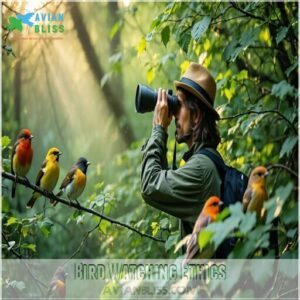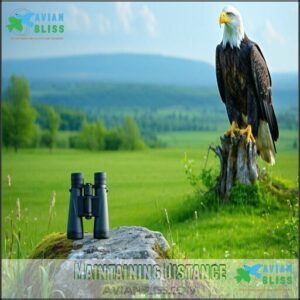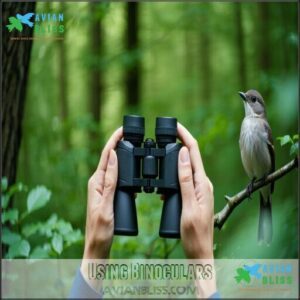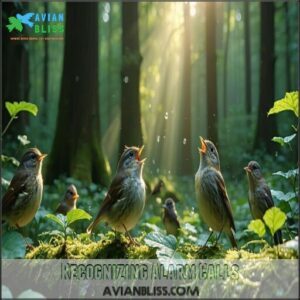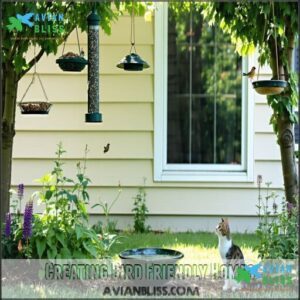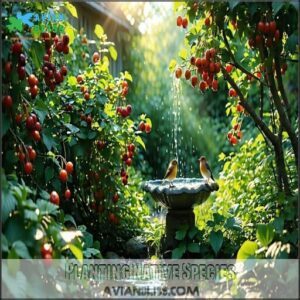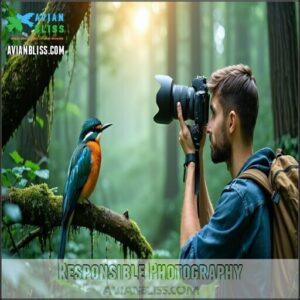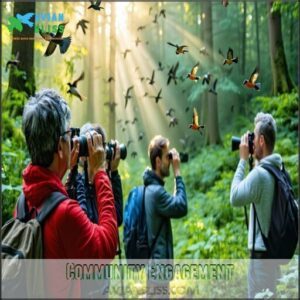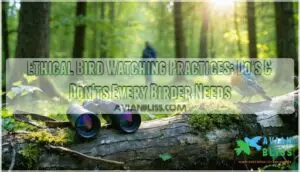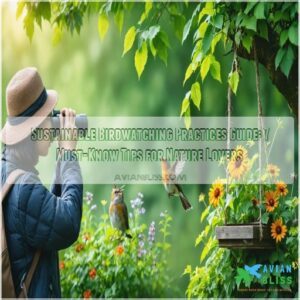This site is supported by our readers. We may earn a commission, at no cost to you, if you purchase through links.

Keep a safe distance—if they’re flying off or calling frantically, you’re too close.
Use binoculars instead of creeping closer, and never touch nests or eggs.
Avoid making loud noises or luring birds with food; it disrupts their natural behavior.
Stick to trails to minimize habitat damage, and learn to recognize alarm calls—they’re like birds saying, “Back off!”
Be mindful of local birding laws and considerate of others when sharing a spot.
By keeping these simple responsible bird watching guidelines in mind, you’ll protect wildlife and make every outing a win-win.
Table Of Contents
- Key Takeaways
- Bird Watching Ethics
- Safe Bird Viewing
- Bird Friendly Practices
- Responsible Photography
- Community Engagement
- Frequently Asked Questions (FAQs)
- What are the ethical guidelines for birds?
- What should you do if you see a bird?
- What should I do if I run into someone while birding?
- Who is learn bird watching?
- What should I do if I find a bird in harm’s way?
- How do you observe a bird?
- What are the 5 S’s of birding?
- What is the protocol for bird watching?
- What is the BIRDIST rule 10?
- What is code 5 in birding?
- Conclusion
Key Takeaways
- Keep your distance and use binoculars instead of approaching birds closely to avoid stressing them out.
- Stay on trails to protect habitats and avoid disturbing nesting areas.
- Don’t use bait, playback calls, or loud noises to attract birds—let them behave naturally.
- Learn to recognize alarm calls and back off if birds show signs of distress.
Bird Watching Ethics
When you’re out bird watching, staying ethical is as important as spotting that rare warbler.
By respecting their space and avoiding harmful practices, you’ll keep birds safer and your conscience clear.
Respecting Birds’ Space
Respecting birds’ space is all about practicing quiet observation and minimizing stress.
Quiet observation keeps birds safe and stress-free while letting you enjoy their natural beauty undisturbed.
Keep yourself a safe nesting distance away and avoid nesting areas entirely.
Follow these responsible birding practices:
- Stay on marked trails for habitat protection.
- Observe bird behavior from afar.
- Use binoculars instead of sneaking closer.
- Avoid loud noises or sudden movements.
- Respect wildlife by maintaining ethical bird photography practices.
To further minimize disturbance, consider the importance of safe viewing distances, which supports responsible birding and helps in maintaining ethical standards.
Minimizing Disturbance
When birding, always think about habitat protection. Stick to trails to avoid trampling fragile plants.
Stay on trails to protect habitats and let nature thrive—small steps make a big impact.
Keep your voice soft—noise reduction helps birds feel secure. Be mindful of nesting areas and back off if you notice stress signals.
Ethical pishing, if used, should be rare and responsible. Seasonal sensitivity matters too—breeding birds need quiet neighbors.
Respect wildlife, always.
Avoiding Harmful Practices
Stick to smart habits to avoid harmful practices while birding.
Limit playback calls and never use baiting—it’s stressful for birds. Reduce noise, and skip flash photography to minimize disturbance.
Follow ethical bird watching guidelines by preserving habitats: stick to trails and avoid trampling vegetation.
Supporting bird welfare means small, thoughtful choices that add up to big impacts.
Safe Bird Viewing
When you’re watching birds, keeping a safe distance helps protect them and lets you enjoy their natural behavior.
Use binoculars to get a closer look without disturbing their peace—this way, nobody gets ruffled feathers!
Maintaining Distance
A safe approach to bird watching means keeping a respectful distance to minimize disturbance.
Birds show stress signals like abrupt movement or alarm calls—don’t ignore them. Stay mindful of nesting proximity and avoid getting too close.
Ethical bird watching uses viewing technology, like binoculars, to protect habitats.
Remember, nothing says “thanks” like leaving birds undisturbed in their own space.
Using Binoculars
Good binoculars make birdwatching easier and more fun.
Magnification matters—choose 8x or 10x for sharp views without shaky hands. A wide field of view helps you track quick flyers.
Look for ergonomic designs that feel natural to hold, especially on long birding trips.
Consider browsing options for specialized birding optics to enhance your viewing experience. Image stabilization in binoculars can level up your birdwatching gear, ensuring crystal-clear focus every time.
Recognizing Alarm Calls
Spotting birds with binoculars is fun, but knowing their stress signals is even more essential.
Alarm calls are nature’s emergency broadcast—sharp, rapid chirps that signal predators or danger. Different species communicate uniquely, so learn their variations.
Stay aware of behavioral changes like sudden silence or frantic movement. By interpreting these calls, you’ll minimize disturbance, respect bird behavior, and follow smart birdwatching guidelines.
To further minimize disturbance, remember to maintain safe distances.
Bird Friendly Practices
You can help birds thrive by making small but meaningful changes at home. Simple actions like keeping cats indoors, planting native flowers, and reducing window collisions make a big difference.
Creating Bird Friendly Homes
Creating a bird-friendly home isn’t rocket science, but it makes a big difference.
Start small with these ideas:
- Keep cats indoors for bird safety and fewer vet visits.
- Use decals or tape to reduce window strikes.
- Place feeders where birds feel safe.
Consider various feeder designs for different birds, such as those found at various feeder designs, and try bird-friendly gardening with native plants for food and shelter.
Clean feeders often to prevent disease.
Reducing Climate Change Impact
After making your home bird-friendly, consider your role in slowing climate change.
Simple actions, like drinking shade-grown coffee or conserving energy, can support bird conservation.
Engage in sustainable birding by reducing waste or advocating for bird-friendly policies.
Here’s a quick guide:
| Action | Impact on Birds |
|---|---|
| Planting native species | Restores habitats |
| Using less electricity | Cuts pollution |
| Supporting conservation | Protects key ecosystems |
Planting Native Species
Protecting birds at home starts with planting native species. Native plants support local ecosystems and attract pollinators like bees and butterflies.
Ready to try bird-friendly gardening? Here’s how:
- Choose plants adapted to your region.
- Avoid invasive species.
- Add layers: trees, shrubs, ground cover.
- Place bird feeders near shelter.
- Focus on sustainable gardening methods.
Consider planting berry-bearing bushes for shelter and food, which supports the overall goal of protecting birds.
Responsible Photography
You don’t need to get too close for the perfect shot—long lenses let you capture stunning details without stressing the birds.
Always prioritize their safety by avoiding flash or disrupting their natural behaviors, and you’ll walk away with photos you can feel good about.
Ethical Photography Guidelines
Respecting nests and avoiding flash are key in ethical bird photography. Use long lenses to capture details while keeping a respectful distance—this minimizes disturbance to birds.
Sharing responsibly prevents overcrowding in sensitive spots. For specialized equipment, consider exploring options for purchasing long lenses.
Here’s a tip: responsible use of recordings also matters—nature’s soundtrack beats interference any day. Check these bird photography tips below:
| Tip | Why It Matters | Practical Example |
|---|---|---|
| Avoid Flash | Prevents startling birds | Use natural light for photos |
| Respect Nests | Protects sensitive areas | Stay at least 100 feet away |
| Minimize Disturbance | Keeps natural behavior intact | Move slowly, use camouflage gear |
The provided table outlines crucial tips for bird photography, emphasizing the importance of respecting nests, avoiding flash, and minimizing disturbance to ensure a positive and non-intrusive experience for both the photographer and the birds.
Avoiding Baiting and Luring
Using bait, lures, or food to attract birds might seem like a shortcut, but it disrupts natural behavior and can lead to food dependency.
Ethical bird photography means respecting bird welfare and minimizing disturbance, relying on responsible attraction methods like spotting birds in their natural habitats.
Avoid impacts on ecosystems—ethical luring respects both habitats and the balance nature’s perfected, ensuring bird welfare and maintaining the natural order, which is crucial for responsible attraction.
Respecting Nesting Sites
When near nesting sites, it’s vital to tread lightly and think about the birds’ safety.
- Keep a safe nesting distance to minimize disturbance birds feel.
- Observe quietly and ditch the flash—bright lights stress them out.
- Protect habitat by staying on trails in bird watching areas.
- Report disturbances, like reckless photographers or off-trail wanderers, to safeguard fragile ecosystems and ensure the safety of the birds.
Community Engagement
When you engage with the birding community, you’re not just spotting feathered friends—you’re building connections with others who share your passion.
Follow local laws, respect fellow birders, and report unethical behavior to keep the experience enjoyable and responsible for everyone, which is crucial for maintaining a positive and responsible community.
Following Local Laws
Laws and regulations aren’t just red tape—they’re keys to ethical birding. Always check permit requirements before venturing into protected areas.
Respect private property and obey seasonal restrictions, like avoiding nesting zones. Stay aware of local noise ordinances to keep birds at ease.
Legal compliance isn’t optional; it keeps habitats safe and guarantees everyone, including the birds, enjoys the outdoors.
Strong laws are critical for habitat restoration efforts, which is essential for maintaining healthy ecosystems and supporting conservation of bird species, ultimately leading to successful habitat restoration.
Respecting Fellow Birders
When joining birdwatching groups, remember that respecting property rights and group size isn’t just polite—it’s part of birding etiquette.
Share your knowledge while respecting skill levels, fostering a sense of community. Positive interactions help the birdwatching community thrive.
Engage with shared resources, listen to others, and create a welcoming environment. After all, birdwatching’s better when everyone enjoys the view!
Reporting Unethical Behavior
Spotting unethical behavior during bird watching? Stay calm and take action!
- Document violations discreetly—snap photos or jot notes.
- Protect your anonymity concerns by reporting to park staff or conservation groups.
- If safe, highlight legal repercussions while explaining bird watching regulations.
Always approach with kindness. You’re not just defending birds—you’re protecting the conservation impact for everyone.
Frequently Asked Questions (FAQs)
What are the ethical guidelines for birds?
Don’t ruffle any feathers—respect birds by keeping a safe distance, staying quiet, and avoiding playback calls.
Stick to trails, keep pets indoors, and never disrupt nests.
Always prioritize their welfare over your curiosity!
What should you do if you see a bird?
Take a deep breath, stay still, and observe quietly.
Use binoculars if you can, but keep your distance.
Avoid startling it with quick movements or noise, and don’t forget to enjoy the moment!
What should I do if I run into someone while birding?
If you meet someone while birding, greet them quietly to avoid disturbing birds.
Share sightings or tips briefly, respecting their space and focus.
Remember, binoculars are for wildlife—pointing them at people’s yards is awkward!
Who is learn bird watching?
Think of learning bird watching like deciphering nature’s secret code.
You’re joining a community that observes, respects, and protects birds.
It’s about curiosity, patience, and inspiring others to appreciate the feathered wonders around us.
What should I do if I find a bird in harm’s way?
If you see a bird in trouble, approach calmly.
Use a towel or gloves to gently handle it, then contact a wildlife rehab center.
Don’t feed it—specialists know what it needs to recover!
How do you observe a bird?
Watch quietly from a distance using binoculars to avoid startling the bird.
Stay still, wear neutral clothing, and observe its behavior.
Notice feeding, flying, or nesting habits—it’s like nature’s reality show unfolding live.
What are the 5 S’s of birding?
The 5 S’s of birding are spotting birds with care, staying quiet to avoid startling them.
Studying their behavior, staying on trails to protect habitats, and showing respect by leaving no trace behind.
What is the protocol for bird watching?
Treat birdwatching like being an invited guest in nature’s home.
Stay quiet, keep your distance, and use binoculars instead of getting too close.
Stick to trails, respect nesting sites, and never disturb birds or their habitats.
What is the BIRDIST rule 10?
The Birdist Rule 10 emphasizes practicing kindness and patience with newcomers.
Share your knowledge without being overbearing, avoid judgment, and make birding enjoyable for everyone.
A little encouragement can turn curiosity into a lifelong passion!
What is code 5 in birding?
A little bird told me Code 5 in birding means documenting rare birds far outside their normal range.
It’s a thrill but requires respect, staying distant, and avoiding anything that stresses or disturbs the bird.
Conclusion
They say, "Leave only footprints, take only memories," and that’s the heart of responsible bird watching guidelines.
Respect birds’ space, stick to trails, and use binoculars instead of getting too close. Keep the habitat intact by avoiding loud noises and never bait or touch nests.
Learn alarm calls—they’re the birds’ way of saying, “Step back!”
By following these simple tips, you’ll enjoy nature while protecting it, creating a win-win for you and wildlife.
- https://ebird.org/pnw/news/birding-ethics-guidelines-for-respecting-birds-their-habitat-and-each-other
- https://www.audubon.org/photography/awards/audubons-guide-ethical-bird-photography-and-videography
- https://www.threeriversparks.org/blog/birding-etiquette-and-how-be-ethical-birder
- https://www.massaudubon.org/places-to-explore/activities/birds-birding/birding-code-of-ethics
- https://www.aba.org/aba-code-of-birding-ethics/

